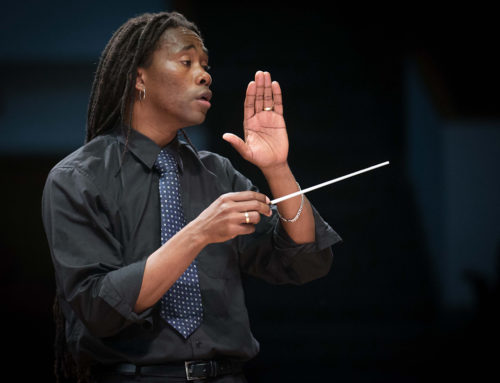The evolution of the opera conductor is a fascinating aspect of music history. In opera, the art of conducting is regarded as the most refined and sophisticated expression of music performance. However, according to Schuller (1997, pp 3) it is the most misunderstood. Throughout different periods of the evolution of music, the figure of the conductor has been perceived in a variety of ways. By the end of the eighteenth century the transformations brought about by the industrial revolution affected the way music was conceived up to that point, as well as the structure of society itself.
Despite the importance of the conductor today there exists little information and even less discussion about the evolution of the role. All this concerns to the metamorphosis of the conductor as we know it today, the distinction between the composer and conductor, and how the conductor (as an extension of the composer) remains devoted to the act of conducting someone else’s music. Additionally, what musical events including compositional processes and practices affected this evolution.
The conductor’s role and evolution from Beethoven (1770–1827) to Wagner (1813–1883) as composers and conductors of their own works. As a preamble for my research project, analysis of a number of their works will be undertaken. This analysis will take the form of examining different sources such as historical journal reviews of performances, journal articles and audio recordings available from the early twentieth century. This initial analysis aims to establish the role of the conductor as an interpreter as well as the relationship with the composer as the creator.
Creator and interpreter were not always two separated entities; this distinction occurred as a result of a series of events in which the figure of the conductor as interpreter achieved a significant position in the art of music making.
Wagner – innovative, controversial and influential, is a unique figure, standing as key in the evolution of music, the art of opera was transformed under his creative genius. The German composer made substantial contributions to the art of opera. His musical conceptions in opera encompass not only writing and
adapting the librettos of his operas but also the composition, production and even the role of entrepreneur. His view of the opera as an integrated artform demands from singers, orchestra and conductor an exacting degree of commitment. He created the concept of “gesamtkunstwerk”. A new era in history was established through his visionary conceptions in music. Wagner set the path for a new generation of creators and interpreters.
The creator and the interpreter
Ward and Wilkinson (2006) define interpretation as the process of transferring meaning from one source to another. In music performance practice, this is one of the most important concepts, in fact, it is the basis of any serious analysis of the interpretations of historical performance. Interpreting someone else’s music is quite common nowadays however, the question arises regarding the fidelity of the interpretation and accuracy in conceptualizing the composer’s initial musical ideas. There are concerns over whether or not the conductor can successfully interpret and perform a musical piece. What are the conductor’s personal considerations as an interpreter and what are the boundaries established by the composer as the genuine creator?
By the end of eighteenth century some remarkable changes had occurred. As a consequence of the French Revolution and the Industrial Revolution, the entrepreneurial facet in art was introduced. In the music scene, the figure of the maestro di cappella was modified and replaced by introducing the independent musician.
As a result of the growing complexity of the music, difficulties of the structure and phrasing, and the expansion of the orchestral range between earlier and later operatic styles, additional demands were placed on the conductor. Decision making is an important aspect of the role of the conductor.
References
Clive, H. P. (2001). Beethoven and His World: A Biographical Dictionary, Oxford University Press.
Ellison, Paul. The Key to Beethoven, Boydell & Brewer, 2014. ProQuest Ebook Central. ttp://ebookcentral.proquest.com.ezproxy1.library.usyd.edu.au/lib/usyd/detail.action?docID=4800949.
Galkin, E. W. (1988). A History of Orchestral Conducting: In Theory and Practice, Pendragon Press.
Hatten, R. S. (2004). Interpreting Musical Gestures, Topics, and Tropes: Mozart, Beethoven, Schubert, Indiana University Press.
Kropfinger, K. (1991). Wagner and Beethoven: Richard Wagner’s Reception of Beethoven, Cambridge University Press.
Newman, E. (2014). Wagner as Man and Artist, Cambridge University Press.
Parry, C. (2009). Beethoven. In Studies of Great Composers (Cambridge Library Collection – Music, pp. 156-194). Cambridge: Cambridge University Press. doi:10.1017/CBO9780511693861.006
Pestelli, G. (1984). Beethoven. In E. Cross (Trans.), The Age of Mozart and Beethoven (pp. 167-260). Cambridge: Cambridge University Press. doi:10.1017/CBO9780511597275.006
Pestelli, G. (1984). The Age of Mozart and Beethoven, Cambridge University Press.
Sasnett, K. Twenty-Five Works for Dramatic Soprano Voice and Orchestra. Journal of Singing – The Official Journal of the National Association of Teachers of Singing; Mar 2009; 65, 4; Arts Premium Collection. pg. 407.
Schuller, G. (1998). The Complete Conductor, Oxford University Press.
Stanley, G. (2000). The Cambridge Companion to Beethoven, Cambridge University Press.
Tovey, D. F. (2015). Symphonies and Other Orchestral Works: Selections from Essays in Musical Analysis, Dover Publications.
Ward, C. W. and A. E. Wilkinson (2006). Conducting Meaningful Interpretation: A Field Guide for Success, Fulcrum Pub.
Williams, S. (2004). Wagner and the Romantic Hero, Cambridge University Press.





Leave A Comment